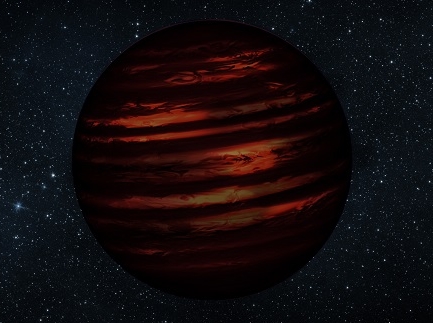The boundary between brown dwarf and planet is poorly defined, although objects over about 13 Jupiter masses (and up to 75 Jupiter masses) are generally considered brown dwarfs. Brown dwarfs do not reside, like most stars, on the main sequence, being not massive enough to sustain nuclear fusion of hydrogen in their cores, although deuterium and lithium fusion is a possibility. But new work on a brown dwarf called SIMP J013656.5+093347 (mercifully shortened to SIMP0136) is giving us fresh insights into the planet/dwarf frontier.

The intriguing object is found in the constellation Pisces, the subject of previous studies that focused on its variability, which has been interpreted as a signature of weather patterns moving into and out of view during its rotation period of 2.4 hours. Now Jonathan Gagné (Carnegie Institution for Science) and an international team of researchers have put new constraints on SIMP0136, finding it to be an object of planetary mass.
Image: Lead author Jonathan Gagné. Credit: Carnegie Institution for Science.
Faint brown dwarfs and cold planetary-mass objects repay close study because as we move just below the deuterium burning mass boundary we are looking at objects much like the gas giants we can observe in exoplanetary systems. But the observations are tricky: Although these borderline objects have physical properties like temperatures, clouds, surface gravities and masses similar to gas giant planets, they also cool down with time, so that their masses cannot be deduced from their effective temperatures alone.
We also need to know about the age of the object we’re looking at, and it is here that the new work helps. Using data from the Near Infrared Spectrometer (NIRSPEC) on the Keck II instrument at Mauna Kea, Gagné and team have identified SIMP0136 as a likely member of the 200 million year old Carina-Near moving group. Moving groups are groups of similarly aged stars moving together through space, offering the possibility of dating any objects that can be associated with them. This faint brown dwarf clearly fits the bill.
Knowing not just the temperature of an object but its age as well, we can calculate its mass. SIMP0136 turns out to be just below the borderline we normally assign to the smallest brown dwarfs. The object has a mass of 12.7 Jupiter masses, plus or minus 1 Jupiter mass.
Assuming that this object is indeed a free-floating planet as opposed to a brown dwarf, it becomes part of a useful category in this mass range. Studying an exoplanetary atmosphere within a distant star system is complicated by the light of the central star, although with closely orbiting gas giants, the possibility of studying starlight filtered through their atmospheres during transits is available. But atmospheric studies of free-floating worlds are easier to conduct in detail, once we have made the key distinction between planetary status and star.

Image: An artist’s conception of SIMP J013656.5+093347, or SIMP0136 for short, which the research team determined is a planetary-like member of a 200-million-year-old group of stars called Carina-Near. Credit: NASA/JPL, slightly modified by Jonathan Gagné.
We’re also dealing with an object that is relatively close to the Sun. At a distance of just under 20 light years, it is the nearest known member of any young stellar moving group and among the 100 nearest systems to the Sun. SIMP0136 turns out to be, the authors add, “…an even more powerful benchmark than previously appreciated and will help [us] to understand weather patterns in gaseous giant atmospheres.”
Cold planetary-mass objects like this one can be found almost anywhere in the sky, since they are not in orbit around a star. That makes them hard to discover. No wonder we’ve only found about twelve objects on the brown dwarf / planet boundary, and most of these have yet to be confirmed by radial velocity measurements. We should have more soon, because this discovery is one of the early results from the BANYAN All-Sky Survey-Ultracool (BASS-Ultracool), which intends to locate similar young brown dwarfs in moving groups, aiming to explore the properties of planetary-mass objects with cold atmospheres.
The paper is Gagné et al., “SIMP J013656.5+093347 is Likely a Planetary-Mass Object in the Carina-Near Moving Group,” accepted at Astrophysical Journal Letters (preprint).



Another strangely, personally timely article! Last night I was reading about rogue planets in Paul Davies’ 2010 book “The Eerie Silence” (he posited Jovian-type ones as possible abodes of simple life). Massive, hot rogue planets and brown dwarfs might be hard to tell apart (especially if they have no discernible-from-Earth [non-transiting, say] satellites by whose orbital motions their primaries’ masses could be determined), and both types of objects might have similar proper motions.
I am wondering if these free floating objects could have a different number and mass of moons than say in our system. Since they form without a central star there would be no influence of other massive objects in the system to disrupt moon formation. We could have much larger moons say around mars to earth sized in orbit about them, but having said that they would eventually be cold dead worlds.
Fascinating subject, thanks for presenting this.
I had a thought about ‘discernable-from-Earth satellites…I hope my post is not silly, perhaps someone could comment. Jupiter is bright enough in the decametric radio wavelengths to be detected on Earth as powerful noise ‘storms’ with an ordinary short wave radio. If a hot planet (or even a brown dwarf) has a similar magnetic torus and proportional output is it feasible to build an antenna suitable to make such a detection from 20 ly?
I am thinking about the effect of Jupiters moons, especially Io on the radio emissions. Could be another window.
Speaking of Io…
http://lbtonews.blogspot.com/2017/05/waves-of-lava-seen-in-ios-largest.html
that is an amazing achievement. Parts of Io are really quite hospitable temperature wise that is. thanks for the link
The same type of emission? No. The background noise from stars and various nebulae (synchrotron radiation) is very strong at these frequencies (~20 MHz). What I have seen discussed as possibly detectable are more energetic atmospheric discharges. Think of extreme lightning. Unfortunately I have no references handy.
Hi, non-expert here. I’ve been wondering, what if there is no discernible classification boundary between a gas giant planet and a brown dwarf? I’m not aware of any further discussion on this following Chen & Kipping’s paper?
http://www.planetary.org/blogs/guest-blogs/2016/0415-favorite-astro-plots-4-classifying-exoplanets.html
I don’t think there is a boundary as such, but there is a plano-stellar plateau as they these objects just get denser and denser (gas compression mostly, if not all) until they ignite, fusion of some sort.
NOT SO FAST!!! Theory becomes FACT!!! The REAL main sequence star-Brown Dwarf cutoff point has just been PROVEN to be 0.067Mj! arXiv.org/abs/1703.05775. “Individual Dynamical Masses of Ultracool Dwarfs”. by Trent J. Dupuy, Michael C Liu.
You mean 0.067 M(sol), you have indicated Jupiter mass.
https://arxiv.org/abs/1703.05775
Yes. I did mean 0.067Ms. Sorry about that.
Citizen Scientists Comb Images To Find An ‘Overexcited Planet’
June 1, 2017 at 3:25 PM ET
Professional astronomers have been turning to the public for help with their research. So far, these “citizen scientists” have helped characterize distant galaxies and discovered gravitation lenses.
Now you can add finding brown dwarfs to the list. An article just published in Astrophysical Journal Letters describes a brown dwarf discovered with the help of four volunteers through an online crowdsourced search.
The project is called Backyard Worlds: Planet 9. When NPR reported on it in February, the focus was on finding the planet that astronomers predict exists at the farthest reaches of the solar system.
But from the start, a second goal was to find brown dwarfs in the sun’s celestial neighborhood — within about 300 light-years.
Full article here:
http://www.npr.org/2017/06/01/530766624/citizen-scientists-comb-images-to-find-an-overexcited-planet
The home site for helping humanity find objects past Neptune and brown dwarfs – and maybe both….
https://www.zooniverse.org/projects/marckuchner/backyard-worlds-planet-9